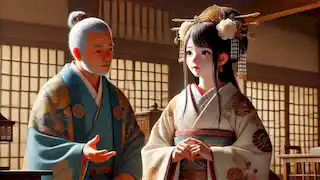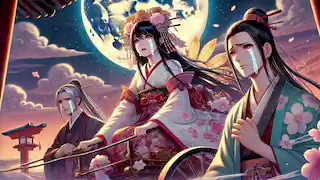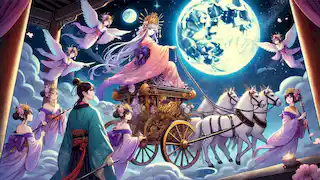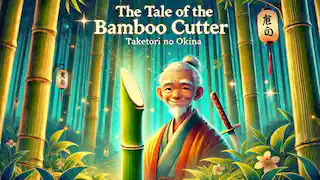The Discovery
Once upon a time, in ancient Japan, there lived a humble bamboo cutter named Taketori no Okina. He was an old man, kind and gentle, who spent his days traversing the dense bamboo forests that surrounded his village, carefully selecting the finest bamboo to cut and sell in the marketplace. One day, while he was working in the forest, he noticed a strange, glowing bamboo stalk. Intrigued, he decided to investigate.
As he approached the luminous bamboo, he saw that it glowed with a mystical light, unlike any he had ever seen. With careful hands, he cut the stalk open, and to his astonishment, inside was a tiny, exquisite girl, no larger than his thumb. She was incredibly beautiful, with delicate features and a radiant smile.
The old bamboo cutter was both surprised and delighted. He gently picked up the tiny girl and brought her home to his wife, Oyu no Okina. They had always longed for a child, and now it seemed their prayers had been answered.
"Look what I found in the bamboo forest," he said, showing his wife the tiny girl.
Oyu no Okina was equally astonished. "She is a gift from the gods," she said, her eyes filled with tears of joy. "We shall raise her as our own daughter."
They named her Kaguya-hime, which means "radiant princess." Over the following days, Kaguya-hime grew rapidly, transforming from a tiny girl to a beautiful young woman of exceptional grace and beauty.

Kaguya-hime's Admirers
As Kaguya-hime grew, her beauty became renowned throughout the land. Many suitors, including noblemen and princes, traveled from afar to seek her hand in marriage. However, Kaguya-hime, despite her kindness and grace, did not wish to marry any of them. She set each suitor an impossible task, hoping they would eventually give up.
The first suitor, Prince Ishitsukuri, was asked to bring her the stone begging bowl of the Buddha from India. The second, Prince Kuramochi, was tasked with fetching a jeweled branch from the mystical island of Horai. The third, the wealthy Prince Abe, was to retrieve a robe made of the fur of the fire-rat from China. The fourth, the ambitious Prince Otomo, was given the mission to bring back a colored jewel from a dragon's neck. The fifth, the mighty Prince Iso, was challenged to find a cowrie shell born from a swallow.
Despite their wealth and power, each suitor failed in his quest. Some tried to deceive Kaguya-hime with fake items, but she saw through their tricks and sent them away, disappointed and humiliated.
The Emperor's Proposal
News of Kaguya-hime's beauty and the failed attempts of her suitors reached the ears of the Emperor himself. Intrigued, he decided to visit the bamboo cutter's home to see her for himself. When he arrived, he was immediately captivated by her beauty and grace.
"Kaguya-hime," he said, "I have heard much about your beauty and your wisdom. Will you come to my palace and be my Empress?"
Kaguya-hime looked at the Emperor with gentle eyes. "Your Majesty, I am deeply honored by your proposal," she replied. "However, I cannot accept. I am not of this world, and my time here is limited."
The Emperor was both saddened and puzzled by her response. "Why do you say you are not of this world?" he asked.
Kaguya-hime sighed. "I come from the Moon, and soon I must return. I was sent here as a punishment for my previous life, but now my time on Earth is nearly over."
The Emperor was heartbroken but respected her wishes. He left the bamboo cutter's home, vowing to protect Kaguya-hime until the day she had to leave.

The Farewell
As the day of her departure approached, Kaguya-hime grew increasingly sad. She loved her adoptive parents deeply and did not want to leave them. She spent her remaining days with them, cherishing every moment.
One evening, as the full moon rose high in the sky, a celestial chariot descended from the heavens, accompanied by a retinue of beautiful maidens. They had come to take Kaguya-hime back to her home on the Moon.
The bamboo cutter and his wife wept as they realized the time had come to say goodbye. "Please, don't take her away," they pleaded with the celestial beings. "She is our daughter, and we love her more than anything in the world."
Kaguya-hime, too, was in tears. "I will always remember you," she said, embracing her parents one last time. "You have given me a lifetime of happiness and love. I will never forget you."
With a heavy heart, she stepped into the chariot. As it ascended into the sky, she looked back at the bamboo cutter and his wife, waving farewell.

The Emperor's Regret
The Emperor, who had been watching from a distance, was also overcome with sorrow. He sent his most trusted warriors to try and bring Kaguya-hime back, but they were powerless against the celestial beings. Helplessly, he watched as the chariot disappeared into the night sky.
Filled with regret, the Emperor wrote a letter to Kaguya-hime, expressing his love and sorrow. He gave the letter to his messengers, instructing them to deliver it to the highest peak in Japan, in the hopes that it might reach her on the Moon.
The messengers climbed to the summit of Mount Fuji, the tallest mountain in Japan, and burned the letter along with some of the Emperor's elixirs of immortality. As the smoke rose into the sky, it was said to carry the Emperor's message of love and longing to Kaguya-hime.
From that day on, the smoke from Mount Fuji has continued to rise, a symbol of the Emperor's undying love and the memory of the radiant princess who had touched the hearts of all who knew her.
Epilogue: The Legacy of Kaguya-hime
The tale of Kaguya-hime became a legend, passed down through generations. The bamboo cutter and his wife, though heartbroken, found solace in the knowledge that their beloved daughter had returned to her true home.
Years later, the Emperor continued to honor Kaguya-hime's memory. He would often gaze at the Moon, wondering if she was looking back at him. Though they were worlds apart, their love remained eternal.
Kaguya-hime, from her celestial abode, watched over her adoptive parents and the Emperor. She never forgot the love and kindness they had shown her during her time on Earth. And every full moon, when the night was clear, her radiant beauty could be seen, reminding all who looked up at the sky of the timeless tale of the bamboo cutter and the princess from the Moon.

Reflection on the Tale
The Tale of the Bamboo Cutter, also known as "The Tale of Princess Kaguya," is one of Japan's oldest and most beloved folktales. It has been interpreted in many ways, often seen as a story about love, loss, and the transient nature of life. The themes of the tale resonate deeply, reminding us of the beauty and impermanence of our own lives.
Through the story of Kaguya-hime, we learn about the power of love and the pain of separation. The bamboo cutter and his wife symbolize the unconditional love of parents, while the Emperor's unfulfilled longing represents the universal experience of unattainable desires.
Kaguya-hime's return to the Moon can be seen as a metaphor for the soul's journey back to its origin, reflecting Buddhist beliefs about the cycle of life, death, and rebirth. Her story continues to inspire and captivate audiences, embodying the timeless allure of Japanese folklore.
Conclusion
The Tale of the Bamboo Cutter remains a poignant and enduring legend, celebrated for its rich storytelling and profound themes. It reminds us that even in the face of loss and separation, love endures, transcending the boundaries of time and space.
As we look up at the Moon and remember Kaguya-hime, we are reminded of the beauty and fragility of life, and the enduring power of love that connects us all.



















